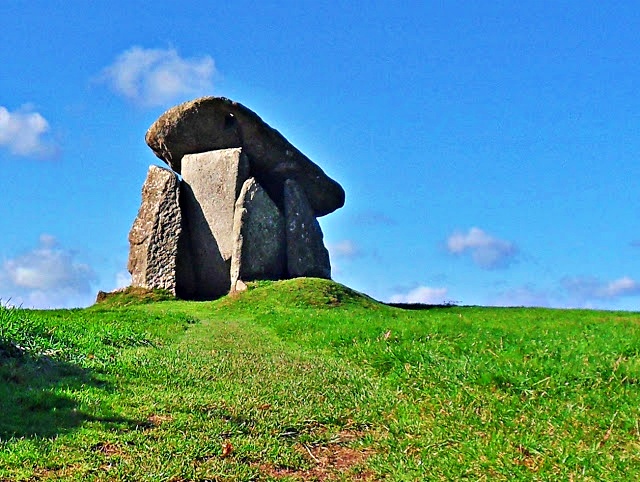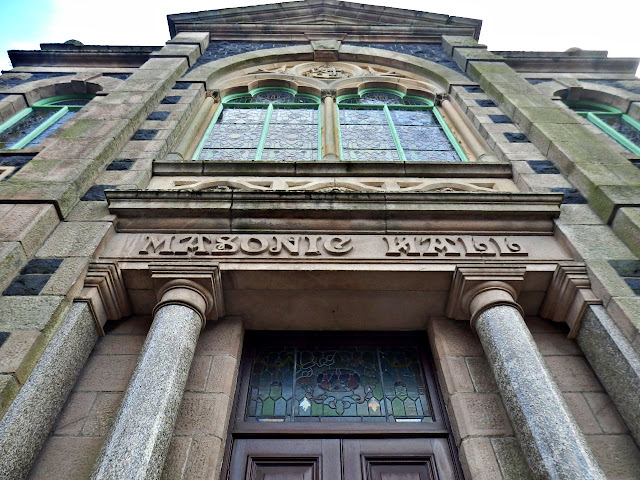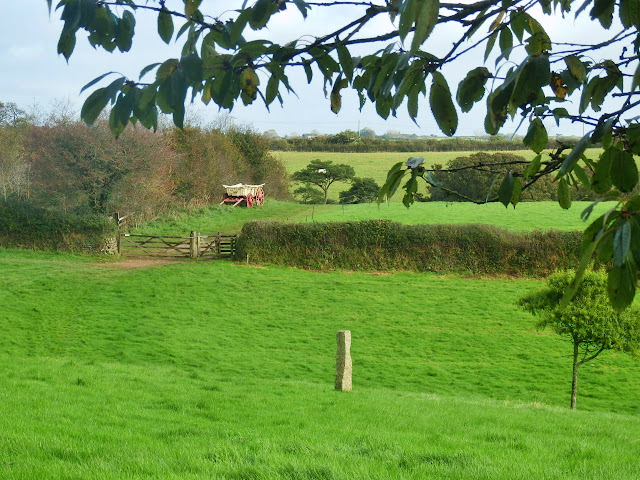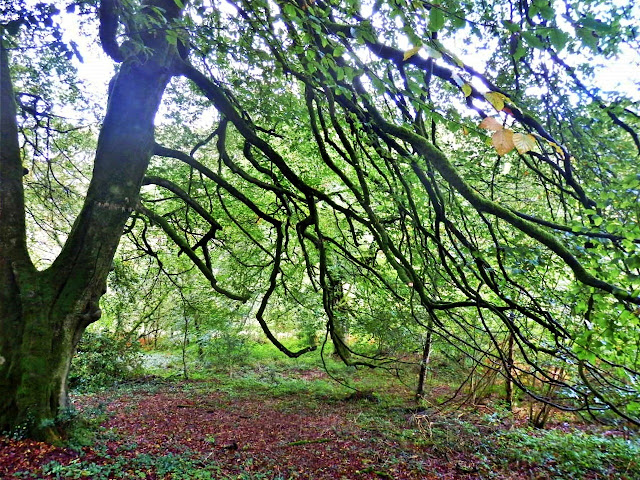Saturday 16 November 2019
The Golitha Falls on the Fowey River and Other Nearby Interesting Places to Visit
We stopped for a brief while at Golitha Falls, which is part of the Fowey River, Cornwall. The falls are always fast moving as they descend some 300 feet.
The Draynes Bridge, above, was built back in 1876, and is made of local granite stone.
There is a story that the last King of Cornwall, Doniert, drowned in the river in the year 875.
King Doniert's Stone is nearby, see my post: The Ancient Stone, Over 1100 Years Old, Known As King Doniert's Stone
Also nearby are the Three Hurlers Ancient Stone Circles on Bodmin Moor.
And, nearly forgot, the Jamaica Inn, as featured in Daphne Du Maurier's book of the same name, is also within easy reach from the falls.
The Golitha Falls are managed by Natural England and this is described as a site of Special Scientific Interest. It is claimed that there are over 98 rare mosses to be found here and 50 species of liverwort.
Draynes woods, through which the falls flow, is an ancient woodland of oaks and hazel coppices. All in all it's an interesting spot to visit and has some marked walks.
The Golitha Falls are 3 miles north-west of Liskeard and 1.2 miles west of St.Cleer. At St.Cleer you will also find the 5000 Years Old Mysterious Trevethy Quoit - photo below taken in the summer!
Wednesday 13 November 2019
The Witch Tamsin and a Story of Witchcraft
Living in Cornwall there are many legends and stories of witchcraft. One of the most famous of Cornish witches was Tamsin Blight (1798-1856) the lady in the photo above. She was also known as Tammy Blee or the White Witch of Helston.
Blight commenced her craft around 1830. She soon built a reputation of being able to remove spells, which had been cast by other witches. People, especially farmers, would consult her for cures for their animals or themselves.
One of the most quoted stories about her is known as The Ghost of Stythians. This is where she attempted to conjure up the spirit of an old woman in St. Stythians graveyard. This was carried out to discover where a large sum of cash was hidden, by the deceased, that a relative claimed was rightfully his.
Following is a description of her actions as described in an 1870 book, Traditions and Hearthside Stories of West Cornwall. The author was William Bottrell.
She marked out a circle by drawing her staff on the ground three times round the man, at the same time mumbling her unknown tongue.
This done, she said, "Now mind, for your life, that you don't move out of this charmed ring which I have made to protect ye, and if you are still determined I will now begin and summon the spirit."
The witch, holding out her staff towards the spot where the old woman was buried, began her incantation, or citation, with long, strange words, slowly pronounced. Then she continued in a louder tone, "Spirit of Jane Hendy, in the name of all the powers above and below, I summon thee to arise from thy grave and to appear before me and this man! By the spirits of fire, air, earth, and water, I summon thee to arise! Come hither, appear, and speak to this man! Come!"
This she said three times, rising her voice at each repetition until it ended in a shriek.
The witch paused. All was silent for a moment, and then were heard, most fearful, because unusual, sounds, which more than any other earthly noise resembled the crashing or rending of wood and stones, mingled with painful moans, groans, and shrieks, which seemed to come from the old woman's grave. The witch, stretching out her arms, her red cloak and grey hair streaming back on the wind, pointed with her staff towards the place whence these frightful sounds proceeded, and said, "Behold, it cometh; be thou prepared!"
The book mentioned is available to be read on the Internet for free here.
Blight commenced her craft around 1830. She soon built a reputation of being able to remove spells, which had been cast by other witches. People, especially farmers, would consult her for cures for their animals or themselves.
One of the most quoted stories about her is known as The Ghost of Stythians. This is where she attempted to conjure up the spirit of an old woman in St. Stythians graveyard. This was carried out to discover where a large sum of cash was hidden, by the deceased, that a relative claimed was rightfully his.
Following is a description of her actions as described in an 1870 book, Traditions and Hearthside Stories of West Cornwall. The author was William Bottrell.
 |
| Stithians / Stythians Church, Cornwall |
She marked out a circle by drawing her staff on the ground three times round the man, at the same time mumbling her unknown tongue.
This done, she said, "Now mind, for your life, that you don't move out of this charmed ring which I have made to protect ye, and if you are still determined I will now begin and summon the spirit."
The witch, holding out her staff towards the spot where the old woman was buried, began her incantation, or citation, with long, strange words, slowly pronounced. Then she continued in a louder tone, "Spirit of Jane Hendy, in the name of all the powers above and below, I summon thee to arise from thy grave and to appear before me and this man! By the spirits of fire, air, earth, and water, I summon thee to arise! Come hither, appear, and speak to this man! Come!"
This she said three times, rising her voice at each repetition until it ended in a shriek.
The witch paused. All was silent for a moment, and then were heard, most fearful, because unusual, sounds, which more than any other earthly noise resembled the crashing or rending of wood and stones, mingled with painful moans, groans, and shrieks, which seemed to come from the old woman's grave. The witch, stretching out her arms, her red cloak and grey hair streaming back on the wind, pointed with her staff towards the place whence these frightful sounds proceeded, and said, "Behold, it cometh; be thou prepared!"
The book mentioned is available to be read on the Internet for free here.
Sunday 10 November 2019
The Church at Veryan, Cornwall: St. Symphorian
A while back I wrote a post about the round Cottages At Veryan, Cornwall - Built To Keep The Devil Away but I didn't mention the village church. So today's post is on Veryan's St. Symphorian church.
The first thing we did was to look at the visitors book and found it amusing that the previous three surnames were Black, White and Brown!
The church dates back to at least the 13th century but it is generally believed that a church has been on this spot for much longer than this. The village itself was mentioned in the Domesday Book of 1086 but was then called Elerchi - which is derived from the Cornish language meaning 'swan'.
The font is of a Norman design but may be a medieval copy.
The font has a carved head on each corner.
The photo below shows some of the impressive roof timbers, many of the carved rafters are thought to be part of the original roof.
The Veryan church adopted St. Symphorian as its patron back in 1281.
According to legend St. Symphorian studied at Autun in France but got into a bit of bother. It seems that he fell out with the local governor, Heraclius, as he refused to worship the pagan goddess Cybele and even tried to destroy the goddess's statue. He was arrested and flogged but stuck to his principles and was finally beheaded on the 22nd of August in the year 178. The date is celebrated every year as St. Symphorian's feast day.
The photo above is of the village stocks resting against the church outside wall. This is how they would have been used ...
Near to the church is a village pond, probably an old mill pond. From here it's possible to walk across country to Cornwall's coast.

Thursday 7 November 2019
It's The Year 6019 at the Masonic Hall in Cornwall
While wandering around St.Austell, Cornwall I remembered the Masonic Hall and snapped a few quick photos. The Hall was built in the year 5900 as can be seen in the photo below. Yes 5900!
The date is also shown below.
AL stands for 'Anno Lucis' and when translated from the Latin means 'Year of Light'. This is a calendar often used by Freemasons.
As I understand this, the Year of Light refers to Genesis in the Bible where God said, "Let there be light." Creationists and many old Bibles give this as happening in the year 4004 BC but the Mason's calendar places the 'event' at the year 4000 BC, which ties in with the often quoted theory that Jesus was actually born in 3 or 4 AD.
Whatever the reason AL is 4000 years different to the calendar popularly used today, so we are now in 6019 AL.
The hall is of the Mark Master Masons.
The Mark Master Masons have been on record since 1756 when a 'brother' was first mentioned as being made a Mark Mason at the Newcastle Masonic Lodge.
As with Freemasons the Mark Masons have various degrees
So why would anyone want this Mark Master Mason's degree? On literature I have seen they give three reasons.
"Firstly, it greatly enhances his knowledge of Craft Masonry. Secondly, it teaches, in a delightful way, many important practical lessons about life. Thirdly, it gives a greater appreciation of the Royal Arch and provides an essential qualification to other Orders of Masonry."
Monday 4 November 2019
The Impossible Pie and Gemstone From Beyond The Grave
A different sort of post today. We visited the church in St.Stephen-in-Brannel, Cornwall (photo at the bottom of the post) to visit the grave of someone special to us. This got me thinking also of my mother and brought back a memory.
When my mother died we came across an old case filled with all sorts of paper bits and pieces she had collected over many years.
One of the slips of paper was the one shown above - a recipe for Impossible Pie. I'd never heard of or seen such a pie previously, but perhaps it is known in other countries.
One of the things mum often said, when I was a child was that, "It's only impossible when you are dead." This would have been when I was moaning about having to do something or other which appeared difficult.
Impossible Pie
Needed
4 eggs
1/4 cup margarine
1 cup white sugar
1/2 cup flour
1/4 teaspoon salt
1/2 teaspoon baking powder
2 cups milk
1 cup coconut
1 teaspoon vanilla
Place all ingredients in blender at one time and blend until mixed together. Pour into a buttered 10" pie dish. Bake in a 350 degree oven for 1 hour. When done, crust will be on bottom, custard in the middle, and coconut on top - right where they belong!
After I had parked the car at St.Stephen-in-Brannel as I stepped out, the first thing I saw was this beautiful, smooth polished stone on the ground. Messages from beyond the grave? Who knows!
When my mother died we came across an old case filled with all sorts of paper bits and pieces she had collected over many years.
One of the slips of paper was the one shown above - a recipe for Impossible Pie. I'd never heard of or seen such a pie previously, but perhaps it is known in other countries.
One of the things mum often said, when I was a child was that, "It's only impossible when you are dead." This would have been when I was moaning about having to do something or other which appeared difficult.
Another saying of hers were words to the effect that everything would work out okay and would fall into place at the right time. Of course, as a child and even a teen, this never seemed realistic.
But mothers know best. Okay, perhaps only some of the time, but like the Impossible Pie things do fall into place in life - if we follow the 'recipe'. It's also true that nothing is impossible.
The first time I read the recipe it felt like a message from my mum.
Just in case you can't read the recipe, here it is again:
The first time I read the recipe it felt like a message from my mum.
Needed
4 eggs
1/4 cup margarine
1 cup white sugar
1/2 cup flour
1/4 teaspoon salt
1/2 teaspoon baking powder
2 cups milk
1 cup coconut
1 teaspoon vanilla
Place all ingredients in blender at one time and blend until mixed together. Pour into a buttered 10" pie dish. Bake in a 350 degree oven for 1 hour. When done, crust will be on bottom, custard in the middle, and coconut on top - right where they belong!
After I had parked the car at St.Stephen-in-Brannel as I stepped out, the first thing I saw was this beautiful, smooth polished stone on the ground. Messages from beyond the grave? Who knows!
Friday 1 November 2019
Old Cornish Ghost Story From 1800's
Another traditional story today from an old book, about 1860, written by Robert Hunt and originally titled: 'The drolls, traditions and superstitions of old Cornwall'. I have copied the ghostly story as it was originally written - so hope you can understand the wording okay. Here goes:
James Berryman said, 'Fa-ther took a house doun to Lelant, whear we lived for a bra' bit.
Very often, after I ben in bed, our cat wud tear up, coover its ars like a ma-aged thing, jump uppon the bed and dig her ould head under the clothes, as if she wud git doun to the bottom, and jest after, a man's face with a light around un wud cum in; 'twas ha-af a face like, and it wud stop at the bottom of the bed.
I've seen it many times; and fa-ther, though he didn't say nothing, was glad enough to leave the place.
I was tould that the house belonged to an ould man, and that two rich gentleman, brothers, that lived close by, wanted the place and put on law, and got the place from the poor ould man. When they war goin' to turn un out, the poor fellow stopped and looked round crying, and then fell down in a fit, was put to bed, and died in the house ... and 'twas he, they said, that used to come back.
Other stories:
Bodmin Jail and a Hanging Watched by 25,000 People Other stories:
A Story of Superstition From Old Cornwall - The White Hare
Who or What are Cornish Knockers?
Tuesday 29 October 2019
Walking Through The Lost Gardens of Heligan, Cornwall
In a recent blog post I mentioned that The Lost Gardens of Heligan had been Voted UKs Top Visitor Garden. I think one of the reasons is that there is always something different to view as the seasons change. Today's photos were all taken on in October.
The Giant's Head, as in the photo above, is found in Heligan's woodland walk along with the Mud Maid.
Below is an entrance to one of the formal gardens but ...
… on our visit we headed for the green fields. Wet underfoot but the sky was doing its best to brighten the way.
Looking across the fields the rain has made them a lovely shade of green.
In an adjoining field an old fashioned hay wagon can be seen. This is still all part of Heligan.
Moving on we come to the jungle.
After all of the rain and dampness it's a good time to spot various fungi. The display below looks like the head of some sort of cattle - or perhaps that's just my imagination.
The palm tree below is losing some of it's outer covering.
Flowers at last, though dotted with raindrops.
More like a woodland walk now ...
… with a path leading through the trees.
The pathway meanders by the some ferns.
Then a display of flowers, good to see in October.
And finally, passing by one of the greenhouses I noticed the staff had made a small display inside.
That's the end of our walk, but we have only covered a very small part of The Lost Gardens of Heligan's 200 acres.
To see many more photos of the Lost Gardens of Heligan just enter 'Heligan' into the search box at the top of this blog to the right.
Subscribe to:
Posts (Atom)
FEATURED POST
A Day in Cornwall: Charlestown, St.Austell, Heligan
A few photos from the last week when we were out and about. Above is the port at Charlestown and below is looking out to sea from the harbo...







































